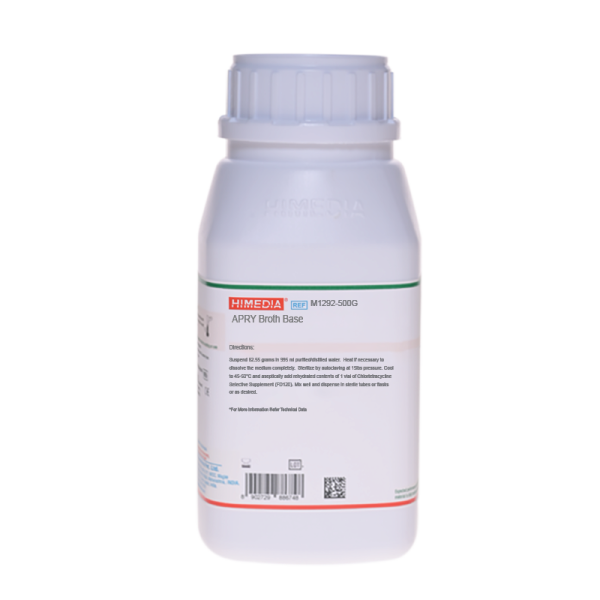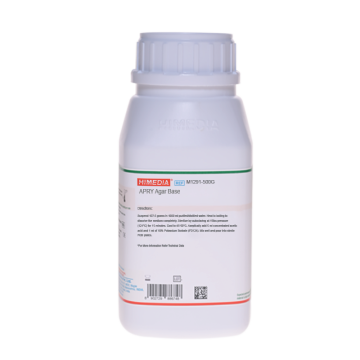 Your enquiry has been submitted
Your enquiry has been submitted
APRY Broth Base
Intended Use:
Recommended for the detection and cultivation of acid resistant yeasts, Zygosaccharomyces bailii and Zygosaccharomyces rouxii in salads, sauces and dressings.
Composition**
| Ingredients | Gms/Litre |
|---|---|
| Peptone | 5.000 |
| Tryptone | 15.000 |
| Yeast extract | 2.500 |
| Dextrose (Glucose) | 30.000 |
| Fructose | 20.000 |
| Chloramphenicol | 0.050 |
| Polysorbate 80 (Tween 80) | 10.000 |
| Final pH (at 25°C) | 6.0±0.2 |
**Formula adjusted, standardized to suit performance parameters
Directions
Suspend 82.55 grams in 995 ml purified / distilled water. Heat if necessary to dissolve the medium completely. Sterilize by autoclaving at 15 lbs pressure (121°C) for 15 minutes. Cool to 45-50°C and aseptically add rehydrated content of 1 vial of Chlortetracycline Selective Supplement (FD120). Mix well and dispense in sterile tubes or flasks.
Principle And Interpretation
Preservation of salads, salad dressing usually depends on the vinegar (acetic acid) or lemon juice present. The microflora causing salad dressings to spoil seems quite restricted. These spoilage organisms come from the ingredients, from manufacturing equipment or from air (3). Yeast Zygosaccharomyces has a long history of spoilage in the food industry (4). Zygosaccharomyces species is described as osmophilic, suggesting a habitat restricted to high solute environments. Zygosaccharomyces is extraordinarily resistant to common preservatives used in juice, concentrates and wine.
APRY Broth Base contains peptone, tryptone and yeast extract which provide carbonaceous and nitrogenous compounds, vitamin B Complex and other growth nutrients. Glucose and fructose provide an energy source. Polysorbate 80 serves as a source of fatty acids. The combination of chloromphenicol and chlorotetracycline is more effective in inhibiting bacterial flora.
Type of specimen
Food samples
Specimen Collection and Handling:
For food samples, follow appropriate techniques for sample collection and processing as per guidelines (3).
After use, contaminated materials must be sterilized by autoclaving before discarding.
Warning and Precautions :
Read the label before opening the container. Wear protective gloves/protective clothing/eye protection/ face protection. Follow good microbiological lab practices while handling specimens and culture. Standard precautions as per established guidelines should be followed while handling clinical specimens. Safety guidelines may be referred in individual safety data sheets.
Limitations :
- Individual organisms differ in their growth requirement and may show variable growth patterns on the medium.
- Each lot of the medium has been tested for the organisms specified on the COA. It is recommended to users to validate the medium for any specific microorganism other than mentioned in the COA based on the user's unique requirement.
Performance and Evaluation
Performance of the medium is expected when used as per the direction on the label within theexpiry period when stored at recommended temperature.
Quality Control
Appearance Cream to yellow homogeneous free flowing powder
Colour and Clarity of prepared medium Light amber coloured clear solution in tubes
Reaction Reaction of 8.25% w/v aqueous solution at 25°C. pH : 6.0±0.2
pH 5.80-6.20
Cultural Response Cultural characteristics observed with added Chlortetracycline Selective Supplement (FD120),after an incubation at 30° C for 72 hours
| Organism | Growth |
|---|---|
| Zygosaccharomyces bailii DSM 70492 | good-luxuriant |
| Zygosaccharomyces rouxii ATCC 34890 | good-luxuriant |
Storage and Shelf Life
Store between 15-25°C in a tightly closed container and the prepared medium at 2-8°C. Use before expiry date on the label. On opening, product should be properly stored dry, after tightly capping the bottle in order to prevent lump formation due to the hygroscopic nature of the product. Improper storage of the product may lead to lump formation. Store in dry ventilated area protected from extremes of temperature and sources of ignition. Seal the container tightly after use. Product performance is best if used within stated expiry period.
Disposal
User must ensure safe disposal by autoclaving and/or incineration of used or unusable preparations of this product. Follow established laboratory procedures in disposing of infectious materials and material that comes into contact with sample must be decontaminated and disposed of in accordance with current laboratory techniques (1,2).
Reference
- Isenberg, H.D. Clinical Microbiology Procedures Handbook 2nd Editio
- Jorgensen, J.H., Pfaller, M.A., Carroll, K.C., Funke, G., Landry, M.L., Richter, S.S and Warnock., D.W. (2015) Manual of Clinical Microbiology, 11th Edition. Vol. 1.
- Salfinger Y., and Tortorello M.L., 2015, Compendium of Methods for the Microbiological Examination of Foods, 5th Ed., American Public Health Association, Washington, D.C.
- Thomas S. and Davenport R. R., 1985, Zygosaccharomyces bailii, A Profile of Characteristics and Spoilage Activities, Food Microbiology 2:157-169.
| Product Name | APRY Broth Base |
|---|---|
| SKU | M1292 |
| Product Type | Regular |
| Physical Form | Powder |
| Origin | Animal |
| Packaging type | HDPE |
| References | 1. Vanderzant C. and Splittstoesser D. F., (Eds.), 1992, Compendium of Methods for the Microbiological Examination of Foods, 3rd Ed., APHA, Washington, D.C. |
| Customized Product Available | No |






